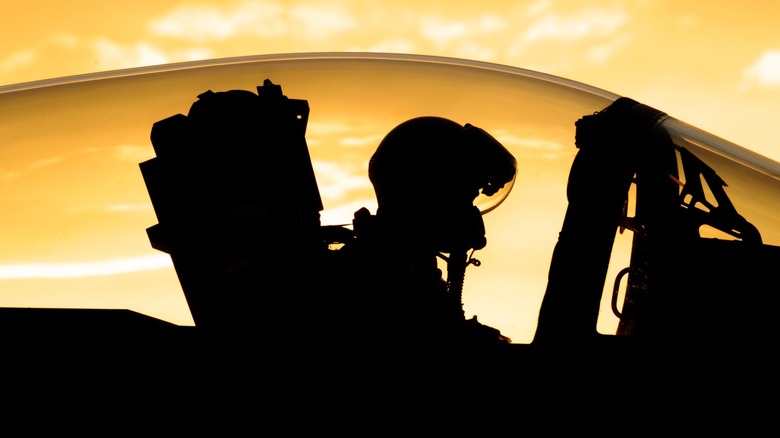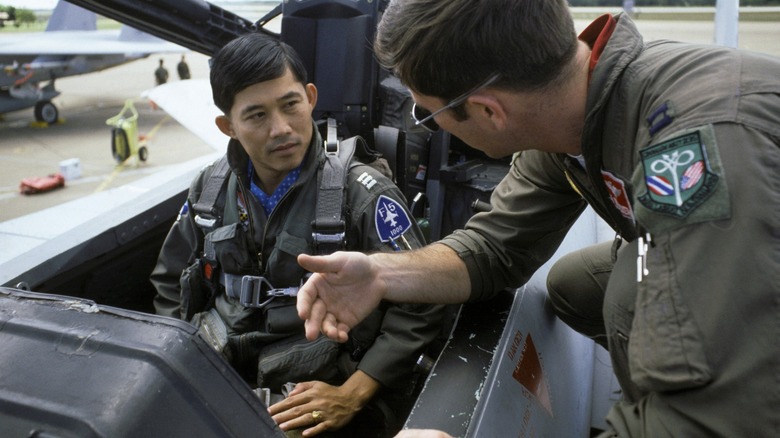An F-15 Passenger Accidentally Triggered A 'Zero-Zero' Ejection On The Runway - Here's What That Means
The F-15 Eagle is one of the United States' best fighters and has proven itself in combat many times since being introduced in 1974. The F-15 is widely regarded as one of the best fighter jets in history, having achieved 104 aerial dogfighting kills and no losses, though some have been destroyed in accidents or taken out by ground-based air defense. Still, it's an impressive fighter jet, and one that anyone enthusiastic about America's air power would love to fly.
While piloting the F-15 Eagle is beyond the reach of most individuals, it is possible to ride in one. The F-15 has many variants, and some, like the F-15D and E, have two seats. The pilot sits in one and flies the plane while the weapon systems officer takes care of the aircraft's ordnance. That second seat isn't needed to fly an F-15, so it's not uncommon for some lucky folks to get to go on a ride-along.
These usually happen without incident, but in August 2025, the unthinkable happened when a passenger accidentally ejected from an F-15 on the runway. This is known as a zero-zero ejection. Ejecting at any time is dangerous, as there's a literal rocket attached to the seat, but it's even riskier for an untrained individual. Fortunately, there were no injuries because the ejection seat functioned as designed by safely ejecting the passenger while at zero airspeed and zero altitude, hence the name zero-zero.
The F-15's zero-zero ejection seat
Military jet ejection seats work in a number of ways, but they weren't initially designed for use while an aircraft is on the ground. Their primary purpose was to get personnel out of a jet as quickly as possible while at high altitude, be it due to the aircraft being out of control or too damaged to land. Several things happen so quickly that it's almost imperceptible: the canopy detaches from the plane, a rocket fires to propel the occupant and their seat from the aircraft, and a parachute deploys to slow their descent as the seat is released.
Zero-zero ejection seats were developed in the 1960s to add a safety feature in case of an emergency before takeoff. This type of ejection seat has become popular, and the much newer F-35 also has a zero-zero seat. In the case of the recent F-15 incident, its zero-zero ejection seat demonstrated its safety capabilities, admittedly by accident. You can see the aftermath of what happened in the video below, posted on X:
Video and ATC from yesterday. The backseater of RAMBO 01 (F-15D 104th FW Massachusetts ANG) accidentally ejected while taxiing back after a alleged incentive flight at Westfield-Barnes Airport, MA
The backseater survived and the runway was shut down. You can see the cockpit... pic.twitter.com/9ZIAV9ENPl
— Thenewarea51 (@thenewarea51) August 14, 2025
A statement from the 104th Fighter Wing (via TWZ) called it "a ground mishap," noting that it occurred around 2:05 pm on August 12 at Barnes Air National Guard Base in Westfield, Massachusetts. After the incident occurred, the Wing shut down flight operations for a 36-hour safety standdown. Flight operations resumed after that period, and no other incidents have been made public since. Despite the violent ejection from the aircraft, nobody was harmed in the accident, showing just how safe and effective the F-15D's ejection seat is.

